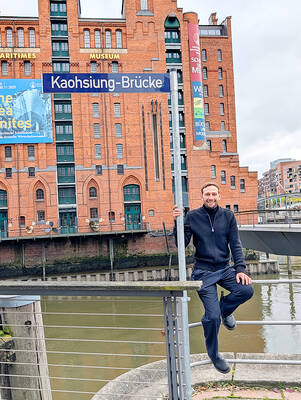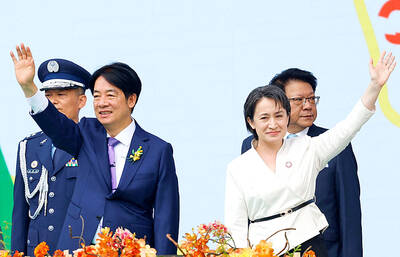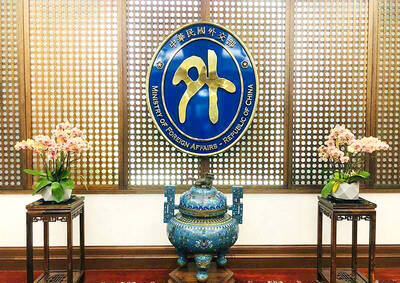The Environmental Protection Administration (EPA) recently conducted measurements of indoor electromagnetic fields in Taipei for the first time, with results indicating that 20 percent of the locations tested had readings of over 10 milligauss (mG).
High readings have been linked to certain health problems.
"That high?" gasped Li Chung-yi (
Li called on the administration to publicize the high-risk locations as soon as possible so that any inappropriate power distribution in schools and hospitals could be adjusted.
Chen Chiao-hua (陳椒華), director of the Taiwan Environmental Protection Union (TEPU), said that if Taipei, the country's capital, was flooded with excessive electromagnetic radiation in this way, then other cities and counties may pay even less attention to their power distribution infrastructure, making it possible that the danger was even greater outside Taipei.
Chen added that although the WHO had yet to publish a report on the effects of electromagnetic radiation, research on infectious diseases shows that small children regularly exposed to 4mG of electromagnetic radiation had an increased risk of developing leukemia, and that for every 1mG above that level, the risk of developing cancer doubles.
From late March to early last month, the administration took electromagnetic radiation readings in Taipei, the country's most densely populated area, hoping to obtain indoor background radiation measures to use as a reference when amending standards.
The EPA conducted tests in all of the city's 12 administrative districts, measuring electromagnetic levels in two hospitals, two communities, two elementary schools and two kindergartens per district. In total, 16 locations were tested and more than 6,000 measurements were taken in each district.
The study showed that 18 percent of elementary school classrooms, hospitals and homes had levels exceeding 10mG. One percent of kindergartens had readings above 10mG, while 16 percent of power distribution rooms and 34 percent of transformer rooms in communities, schools and hospitals had levels above 10mG. Thirty-two percent of areas near high-voltage wires measured above 10mG.
Four percent of power distribution rooms, 11 percent of transformer rooms, and 3 percent of elementary school classrooms, hospitals, homes and areas near high-voltage lines had readings exceeding 30mG.
The EPA said there was no way to verify at present if electromagnetic radiation was harmful to people's health, and added that it was concerned it might cause unfounded worries among the public.
The EPA was therefore unwilling to release the sampling locations and measurements from its tests, and has no plans to continue sampling in other cities or counties.

The German city of Hamburg on Oct. 14 named a bridge “Kaohsiung-Brucke” after the Taiwanese city of Kaohsiung. The footbridge, formerly known as F566, is to the east of the Speicherstadt, the world’s largest warehouse district, and connects the Dar-es-Salaam-Platz to the Brooktorpromenade near the Port of Hamburg on the Elbe River. Timo Fischer, a Free Democratic Party member of the Hamburg-Mitte District Assembly, in May last year proposed the name change with support from members of the Social Democratic Party and the Christian Democratic Union. Kaohsiung and Hamburg in 1999 inked a sister city agreement, but despite more than a quarter-century of

Taiwanese officials are courting podcasters and influencers aligned with US President Donald Trump as they grow more worried the US leader could undermine Taiwanese interests in talks with China, people familiar with the matter said. Trump has said Taiwan would likely be on the agenda when he is expected to meet Chinese President Xi Jinping (習近平) next week in a bid to resolve persistent trade tensions. China has asked the White House to officially declare it “opposes” Taiwanese independence, Bloomberg reported last month, a concession that would mark a major diplomatic win for Beijing. President William Lai (賴清德) and his top officials

The Ministry of Foreign Affairs (MOFA) yesterday expressed “grave concerns” after Singaporean Prime Minister Lawrence Wong (黃循財) reiterated the city-state’s opposition to “Taiwanese independence” during a meeting with Chinese Premier Li Qiang (李強). In Singapore on Saturday, Wong and Li discussed cross-strait developments, the Singaporean Ministry of Foreign Affairs said in a statement. “Prime Minister Wong reiterated that Singapore has a clear and consistent ‘one China’ policy and is opposed to Taiwan independence,” it said. MOFA responded that it is an objective fact and a common understanding shared by many that the Republic of China (ROC) is an independent, sovereign nation, with world-leading

‘ONE CHINA’: A statement that Berlin decides its own China policy did not seem to sit well with Beijing, which offered only one meeting with the German official German Minister for Foreign Affairs Johann Wadephul’s trip to China has been canceled, a spokesperson for his ministry said yesterday, amid rising tensions between the two nations, including over Taiwan. Wadephul had planned to address Chinese curbs on rare earths during his visit, but his comments about Berlin deciding on the “design” of its “one China” policy ahead of the trip appear to have rankled China. Asked about Wadephul’s comments, Chinese Ministry of Foreign Affairs spokesman Guo Jiakun (郭嘉昆) said the “one China principle” has “no room for any self-definition.” In the interview published on Thursday, Wadephul said he would urge China to